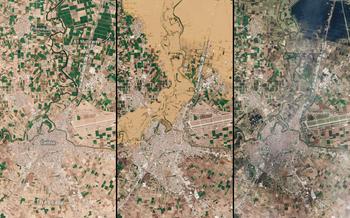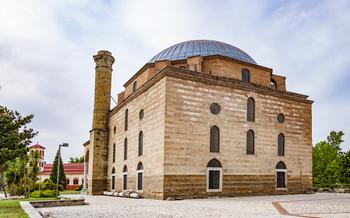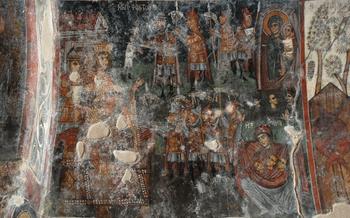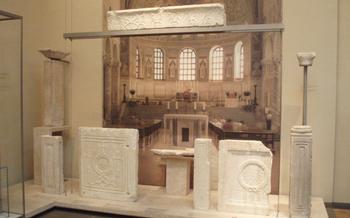
Monastery of Roussanou Meteora
- Monastery of Roussanou Meteora: A Sacred Haven Amidst Majestic Cliffs
- A Journey Through Time: Historical Overview of the Monastery
- The Meteora Monasteries: A Unique UNESCO World Heritage Site
- Reaching the Monastery: A Scenic and Spiritual Adventure
- Marvels of Architecture: Exploring the Monastery's Structures
- Sacred Art and Treasures: Unveiling Hidden Masterpieces
- Monastic Life and Traditions: A Glimpse into Spiritual Devotion
- Pilgrimage and Spirituality: A Journey of Faith
- A Breathtaking Panorama: Views from the Monastery
- Exploring Nearby Monasteries: A Circuit of Sacred Sites
- Hiking and Nature Trails: Immersing in the Landscape
- Off-the-Beaten-Path Gems: Hidden Corners and Secrets
- Planning Your Visit: Essential Tips for a Smooth Journey
- Photography Enthusiasts' Paradise: Capturing the Essence
- Insider Tip: Unveiling a Secret Path
Monastery of Roussanou Meteora: A Sacred Haven Amidst Majestic Cliffs
Perched atop a colossal rock pillar, the Monastery of Roussanou stands as a testament to the ingenuity and devotion of the Eastern Orthodox monks who sought refuge and communion with the divine in the secluded Meteora region of Greece. Its history is intertwined with the spiritual quest of these monks, who transformed these formidable rock formations into a sanctuary of faith and contemplation.
Nestled amidst the awe-inspiring landscape of Meteora, Roussanou Monastery commands breathtaking views of the surrounding countryside. The monastery's location, seemingly suspended between heaven and earth, evokes a sense of tranquility and detachment from worldly concerns. Visitors are immediately captivated by the stunning vistas, where towering cliffs and verdant valleys converge, creating a panorama of natural beauty.
A Journey Through Time: Historical Overview of the Monastery
In the 14th century, as monasticism flourished across the Byzantine Empire, a pious monk named Athanasios Koinovitis sought a place of solitude and spiritual contemplation. Guided by divine inspiration, he ventured into the Meteora region and discovered a series of towering rock pillars, weathered by time and untouched by human presence. These natural wonders became the foundation for the Monastery of Rousanou, one of the most prominent religious sanctuaries in Meteora.
The monastery's early years were marked by hardship and austerity as monks battled the elements and carved out a livable space within the rock's crevices. Over time, the monastery grew in size and influence, attracting devout followers and becoming a center of religious learning and spiritual enlightenment.
During the Ottoman occupation of Greece, the Monastery of Rousanou faced significant challenges, including persecution and threats to its autonomy. However, it managed to endure and preserve its religious traditions, offering solace and guidance to the oppressed Christian community.
Throughout its history, the monastery has played a pivotal role in the preservation and dissemination of Eastern Orthodox Christianity, contributing to the cultural and spiritual heritage of Greece. In the 16th century, it became a stauropegial monastery, directly under the authority of the Patriarch of Constantinople, a testament to its importance within the Orthodox Church.
The Meteora Monasteries: A Unique UNESCO World Heritage Site
The Meteora monasteries stand as a testament to the enduring power of faith and human ingenuity. These architectural marvels, perched atop towering rock pillars, are a geological wonder that has captivated the world's imagination. The unique geological formation of the Meteora rock pillars, shaped by millions of years of erosion, has created a breathtaking landscape that has become synonymous with the region.
In 1988, UNESCO recognized the outstanding universal value of the Meteora monasteries and inscribed them on the World Heritage List. This designation acknowledges the cultural, historical, and religious significance of these sacred sites. The monasteries are not only architectural masterpieces but also bear witness to the spiritual and artistic achievements of the Eastern Orthodox Church.
Today, six of the original 24 monasteries remain active, each with its own unique history and character. These monasteries, suspended between heaven and earth, continue to be places of worship, pilgrimage, and spiritual reflection, attracting visitors from around the world who come to marvel at their beauty and experience the profound sense of peace and tranquility that permeates the atmosphere.
Reaching the Monastery: A Scenic and Spiritual Adventure
The journey to the Monastery of Roussanou Meteora is a breathtaking experience in itself. Nestled atop a towering rock pillar, the monastery can be reached either by foot or by a scenic train ride.
For those seeking a more immersive and challenging experience, hiking to the monastery is a popular option. Several well-marked trails wind through the Meteora rock formations, offering panoramic views of the surrounding landscape. The ascent is steep, but the rewards are immense—the chance to soak in the natural beauty, breathe in the fresh air, and connect with the spiritual energy of the place.
For those who prefer a more leisurely approach, a train ride to the monastery is an equally enchanting option. The train chugs along the base of the rock pillars, providing stunning views of the monasteries perched precariously above. The journey is a sensory feast, with the sound of the train's engine echoing through the valley and the wind rustling through the trees.
When planning your visit, consider your fitness level and preferences. Whether you choose to hike or take the train, the journey to the Monastery of Roussanou Meteora is sure to be a memorable experience.
Practical Tips:
- Wear comfortable shoes and clothing suitable for hiking or walking on uneven terrain.
- Bring plenty of water and snacks, as there are no shops or restaurants along the hiking trails.
- Start your hike early in the morning or late afternoon to avoid the midday heat.
- If taking the train, check the schedule in advance to ensure you don't miss the last train back down.
Marvels of Architecture: Exploring the Monastery's Structures
The Monastery of Roussanou Meteora stands as a testament to the architectural prowess of its builders. Constructed in the 16th century, it harmoniously blends Byzantine and post-Byzantine architectural styles, creating a unique and awe-inspiring edifice.
Within the monastery's confines, visitors will discover a complex of churches, chapels, and living quarters, each meticulously crafted and adorned with intricate details. The main church, dedicated to the Transfiguration of Christ, boasts a stunning dome and vibrant frescoes that depict scenes from the Bible and the lives of the saints.
The monastery's defensive features are equally impressive, showcasing the ingenuity of its builders. Thick walls and strategically placed fortifications protected the monastery from potential invaders, allowing the monks to maintain their spiritual seclusion.
Among the monastery's architectural highlights are its unique and intricate features, such as the elaborate bell tower, the graceful arches, and the beautifully carved lintels. These elements add a touch of elegance and refinement to the monastery's overall design, making it a true masterpiece of Byzantine architecture.
Sacred Art and Treasures: Unveiling Hidden Masterpieces
The Monastery of Roussanou is a treasure trove of sacred art and religious artifacts that captivate visitors with their intricate beauty and profound symbolism. Within the monastery's walls, a dazzling array of frescoes, icons, and religious artifacts unfolds, narrating stories of faith, devotion, and divine intervention.
The frescoes, painted with vibrant colors and meticulous detail, adorn the walls of the monastery's churches and chapels, depicting scenes from the Bible, the lives of saints, and the history of the monastery itself. Each fresco is a testament to the skill and artistry of the monks who created them, using their talents to glorify God and inspire the faithful.
Among the most notable frescoes is the depiction of the Last Supper in the main church, which captures the poignant moment of Jesus sharing his final meal with his disciples. The expressions on the faces of the figures and the intricate details of the composition convey the profound significance of this event in Christian history.
In addition to the frescoes, the monastery houses a collection of exquisite icons, each one a unique masterpiece. These icons, painted on wood or metal and often adorned with precious stones and metals, depict holy figures and scenes from the Bible. They serve as objects of veneration for the monks and pilgrims, who seek their intercession and guidance.
Among the most revered icons in the monastery is that of the Virgin Mary, known as the "Panagia of Roussanou." This icon is believed to have miraculous powers and is often sought by pilgrims seeking healing, comfort, or protection.
The Monastery of Roussanou's collection of sacred art and treasures is not merely a display of artistic prowess but a testament to the deep faith and devotion that have sustained this holy place for centuries. These treasures offer a glimpse into the spiritual world of the monks and pilgrims who have walked these halls, seeking communion with the divine.
Monastic Life and Traditions: A Glimpse into Spiritual Devotion
Within the hallowed walls of the Monastery of Roussanou Meteora, a vibrant community of monks or nuns dedicates their lives to spiritual devotion and service. Their daily routine revolves around prayer, meditation, and the fulfillment of religious obligations. As dawn breaks, the monastery echoes with the melodious chanting of prayers, setting the tone for a day steeped in contemplation and spiritual growth.
Monks and nuns observe strict fasting practices, adhering to a simple and austere diet. Their meals often consist of vegetables, legumes, and bread, reflecting their commitment to self-denial and humility. Through these practices, they seek to purify their bodies and minds, aligning themselves more closely with the divine.
Asceticism, a core principle of monastic life, is embraced by the inhabitants of the monastery. They renounce worldly possessions and embrace a life of simplicity, finding fulfillment in their spiritual pursuits. This renunciation extends to material comforts, as they sleep on simple mats or wooden platforms, embracing discomfort as a means of spiritual growth.
Interaction with visitors and pilgrims is an integral part of monastic life at Roussanou Meteora. The monks and nuns welcome guests with open arms, offering them guidance, blessings, and a glimpse into their unique way of life. Visitors are encouraged to participate in religious ceremonies and services, immersing themselves in the monastery's sacred atmosphere.
The monastery's inhabitants serve as beacons of faith and spirituality, inspiring countless individuals who seek solace, guidance, and a deeper connection with the divine. Through their unwavering devotion and commitment to a life of service, the monks and nuns of Roussanou Meteora embody the essence of monasticism, perpetuating a rich tradition that has endured for centuries.
Pilgrimage and Spirituality: A Journey of Faith
Throughout history, the Monastery of Roussanou Meteora has served as a significant pilgrimage site for devout Christians and spiritual seekers. Pilgrims from across Greece and beyond flock to this sacred haven, drawn by its profound spiritual energy and the opportunity to connect with their faith. The monastery's tranquil atmosphere and stunning surroundings provide an ideal setting for reflection, meditation, and spiritual contemplation.
For many pilgrims, the journey to Roussanou Meteora is a deeply personal and transformative experience. They embark on this pilgrimage to seek blessings, offer prayers, and strengthen their connection with the divine. The monastery's holy relics, icons, and frescoes inspire awe and devotion, while the daily prayers and rituals performed by the monks/nuns create a palpable sense of spirituality.
Throughout the year, the monastery hosts various religious festivals and celebrations that attract large numbers of pilgrims. These events provide an opportunity for the faithful to come together, celebrate their shared beliefs, and participate in traditional ceremonies. The monastery's unique location, perched high atop a towering rock pillar, adds to the sense of awe and wonder that permeates the pilgrimage experience.
For those seeking a deeper spiritual connection, the monastery offers opportunities for private prayer, contemplation, and meditation. Visitors can find solace and peace within the monastery's serene chapels or retreat to the surrounding natural beauty for moments of quiet reflection. The monastery's spiritual atmosphere encourages pilgrims to embark on a journey of self-discovery and transformation, fostering a sense of inner peace and tranquility.
A Breathtaking Panorama: Views from the Monastery
The Monastery of Roussanou Meteora offers breathtaking panoramic views of the surrounding countryside that will leave you spellbound. From the monastery's vantage point high atop the rock pillar, you can feast your eyes on a vast expanse of rolling hills, lush forests, and distant mountains. The panorama is particularly captivating at sunrise and sunset, when the sky transforms into a canvas of vibrant hues, casting a magical glow on the landscape below.
For photography enthusiasts, the monastery provides an abundance of opportunities to capture stunning shots. The unique vantage point allows you to frame the monastery against the backdrop of the majestic rock formations and the picturesque surroundings. With the right lighting conditions and composition, you can create breathtaking images that will serve as lasting memories of your visit.
Take your time to savor the tranquility and beauty of the surroundings. Find a secluded spot to sit and simply soak in the breathtaking views. Let the panorama wash away your worries and fill you with a sense of serenity and awe.
Exploring Nearby Monasteries: A Circuit of Sacred Sites
The Monastery of Roussanou is but one of six spectacular monasteries perched atop the Meteora rock pillars. Each monastery possesses its own unique character and charm, inviting visitors to embark on a sacred circuit of exploration. The Monastery of Great Meteoron, the largest and oldest of the complex, boasts stunning frescoes and panoramic views. The Monastery of Varlaam, renowned for its intricate carvings and well-preserved architecture, offers a glimpse into the monastic life of centuries past. The Monastery of Saint Stephen, nestled amidst lush vegetation, provides a tranquil retreat for spiritual contemplation. The Monastery of Holy Trinity, perched on a towering rock, offers unparalleled vistas of the surrounding landscape. And the Monastery of Saint Nicholas Anapausas, with its serene atmosphere and collection of religious artifacts, invites visitors to immerse themselves in its spiritual aura.
Planning a multi-monastery visit requires careful consideration of time and energy. Visitors can choose to explore all six monasteries in a single day, embarking on a rigorous but rewarding pilgrimage. Alternatively, they can spread their visits over multiple days, allowing ample time to soak in the unique atmosphere of each monastery. Accommodation options near the monasteries range from simple guesthouses to luxurious hotels, catering to a variety of budgets and preferences.
Hiking and Nature Trails: Immersing in the Landscape
The Meteora region offers a paradise for hiking enthusiasts, with a network of well-marked trails winding through the stunning landscape. These trails provide opportunities to explore the natural beauty of the area while immersing in the tranquility and spirituality of the monasteries.
Hikers of all levels can find suitable trails, ranging from easy paths suitable for families with young children to challenging routes that reward with breathtaking views. The trails meander through forests, past caves, and alongside streams, offering a diverse and ever-changing scenery.
The flora and fauna of the region are also a highlight for nature lovers. The area is home to a variety of wildflowers, butterflies, and birds, making it a haven for birdwatchers and nature photographers.
Combining hiking with monastery visits allows visitors to experience the best of both worlds, exploring the natural and spiritual wonders of Meteora. Many trails lead directly to the monasteries, providing a unique and immersive way to approach these sacred sites.
Off-the-Beaten-Path Gems: Hidden Corners and Secrets
While the Monastery of Roussanou Meteora is a renowned and iconic site, there are hidden corners and secrets within the monastery complex and the surrounding area that offer unique and enriching experiences for those willing to venture off the beaten path.
Within the monastery itself, visitors can explore lesser-known areas such as the ancient refectory, where the monks once dined, or the hidden chapel dedicated to a forgotten saint. These secluded spaces offer a glimpse into the monastery's rich history and provide a sense of tranquility away from the main tourist routes.
Beyond the monastery walls, the surrounding villages and towns hold their charms. The village of Kastraki, nestled at the foot of the Meteora rock pillars, offers traditional Greek cuisine in its tavernas and breathtaking views from its cobblestone streets. The town of Kalabaka, a short drive from Meteora, boasts a lively atmosphere, local markets, and museums that delve deeper into the region's history and culture.
Venturing further afield, visitors can discover hidden hiking trails that lead to secluded viewpoints, offering unparalleled panoramas of the Meteora monasteries and the surrounding countryside. These trails, often less crowded than the main tourist paths, allow for a more intimate and immersive experience with nature.
Unveiling the hidden gems of the Monastery of Roussanou Meteora and its surroundings adds a layer of depth and authenticity to any visit. By exploring these lesser-known areas, travelers can gain a deeper appreciation for the monastery's spiritual significance, its historical context, and the vibrant culture of the region.
Planning Your Visit: Essential Tips for a Smooth Journey
To ensure a smooth and enriching experience at the Monastery of Roussanou Meteora and the surrounding area, it is crucial to plan your visit carefully. Here are some essential tips to consider:
-
Timing is Key: The best time to visit the monastery is during the shoulder seasons (spring and autumn) when the weather is pleasant, and the crowds are smaller. Avoid the peak summer months (July and August) if you prefer a more tranquil experience.
-
Accommodation: There are several accommodation options available near the monasteries, ranging from traditional guesthouses to modern hotels. Choose one that suits your budget and preferences. Reservations are highly recommended, especially during the peak season.
-
Packing: Pack comfortable clothing and sturdy shoes suitable for walking and hiking on uneven terrain. The weather in the region can be unpredictable, so bring layers to adjust to changing temperatures. Don't forget a hat, sunscreen, and a water bottle.
-
Respectful Attire: Remember that the monasteries are active religious sites. Dress modestly and respectfully when visiting. Shorts, tank tops, and revealing clothing are not appropriate. Some monasteries may provide visitors with shawls or scarves to cover their shoulders and knees if needed.
Photography Enthusiasts' Paradise: Capturing the Essence
The Monastery of Roussanou Meteora presents a photographer's paradise, offering endless opportunities to capture the monastery's grandeur and the surrounding natural beauty. With its dramatic cliffs, ancient architecture, and stunning views, the monastery provides a feast for the eyes and a challenge for photographers of all skill levels.
To capture the best shots, timing is crucial. The early morning light casts a warm glow on the monastery, creating a magical atmosphere. Alternatively, the golden hues of sunset illuminate the surrounding cliffs, offering a different perspective. Experiment with different angles to find unique compositions that showcase the monastery's architectural details and its harmonious integration with the landscape.
For those seeking a truly breathtaking shot, venture out to one of the nearby viewpoints. These hidden gems offer panoramic vistas that encompass the entire Meteora complex, with the monasteries perched atop the towering rock pillars. The challenge lies in finding the right balance between capturing the vastness of the landscape and highlighting the intricate details of the monastery.
Don't be afraid to experiment with filters and editing techniques to enhance your photographs. Black and white conversions can add a timeless quality to your images, while selective adjustments can emphasize specific elements of the scene. With a bit of creativity and technical skill, you can create stunning photographs that capture the essence of the Monastery of Roussanou Meteora and its awe-inspiring surroundings.
Insider Tip: Unveiling a Secret Path
Beyond the well-trodden paths of the Monastery of Roussanou Meteora, there lies a hidden gem waiting to be discovered. A secret trail, known only to a select few, leads to a secluded viewpoint that offers breathtaking panoramas of the monastery and its surroundings.
To embark on this off-the-beaten-path adventure, follow these steps: As you approach the monastery from the main entrance, keep an eye out for a small, inconspicuous opening in the rock wall on your right. This is the starting point of the hidden trail.
Once you enter the opening, you'll find yourself on a narrow path that winds its way through dense vegetation. Be prepared for a bit of scrambling and climbing as you navigate the uneven terrain. The path is not well-marked, so it's crucial to pay attention to your surroundings and follow the faint traces of footsteps.
As you ascend, the monastery will gradually come into view, perched majestically atop its rocky pedestal. The higher you climb, the more spectacular the vistas become. Take your time, enjoy the tranquility, and soak in the awe-inspiring beauty that unfolds before you.
Finally, you'll reach the hidden viewpoint, a secluded spot that feels like a secret sanctuary. From here, you'll be privy to unobstructed views of the Monastery of Roussanou Meteora, framed against the backdrop of the Pindus Mountains and the vast Thessalian Plain. It's a sight that will leave you speechless and create lasting memories of your visit.
Remember, this secret trail is not for the faint of heart. It requires a good level of fitness and a sense of adventure. Wear appropriate footwear and clothing, and be sure to bring a camera to capture the stunning views. Also, respect the sanctity of the monastery and its surroundings by leaving no trace and maintaining a peaceful demeanor.







